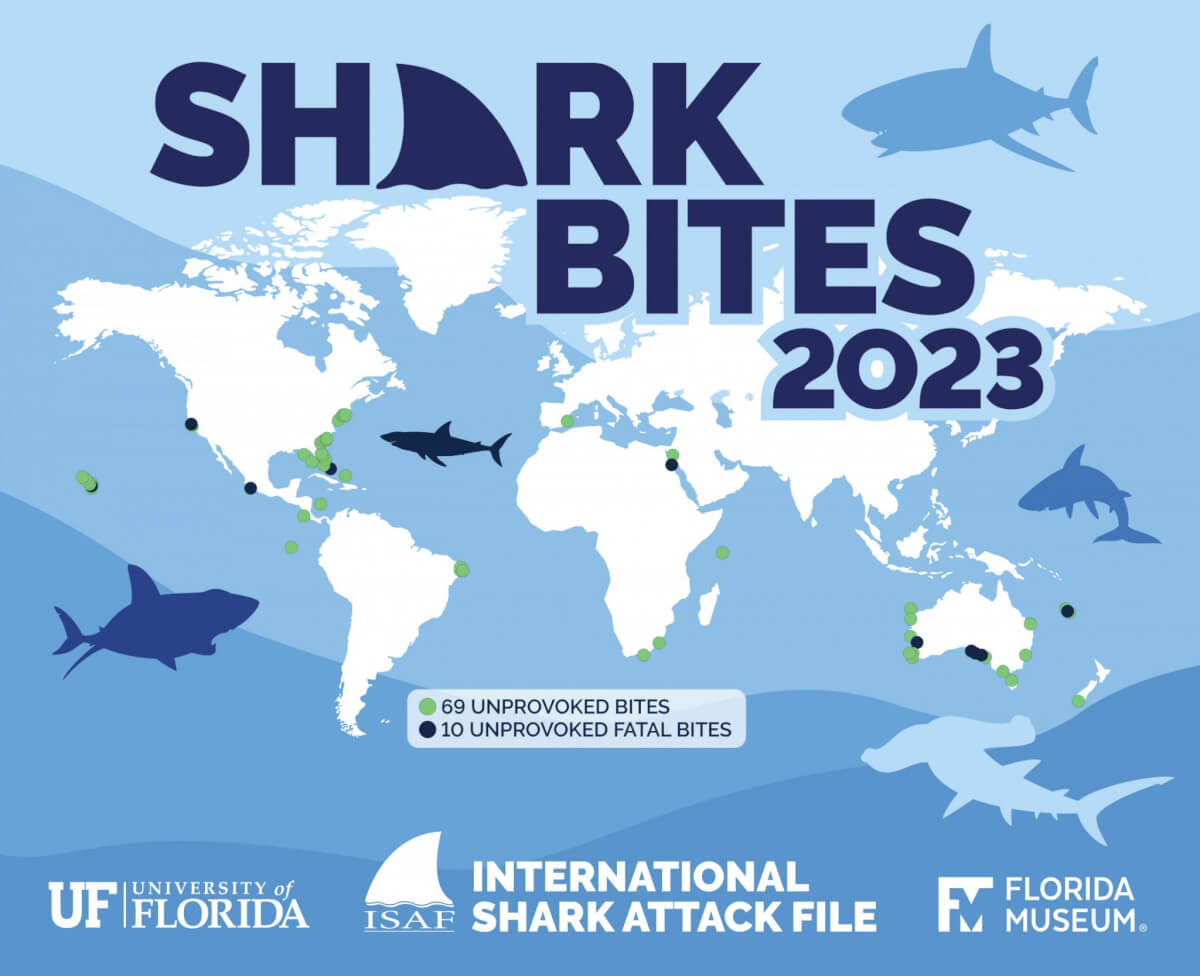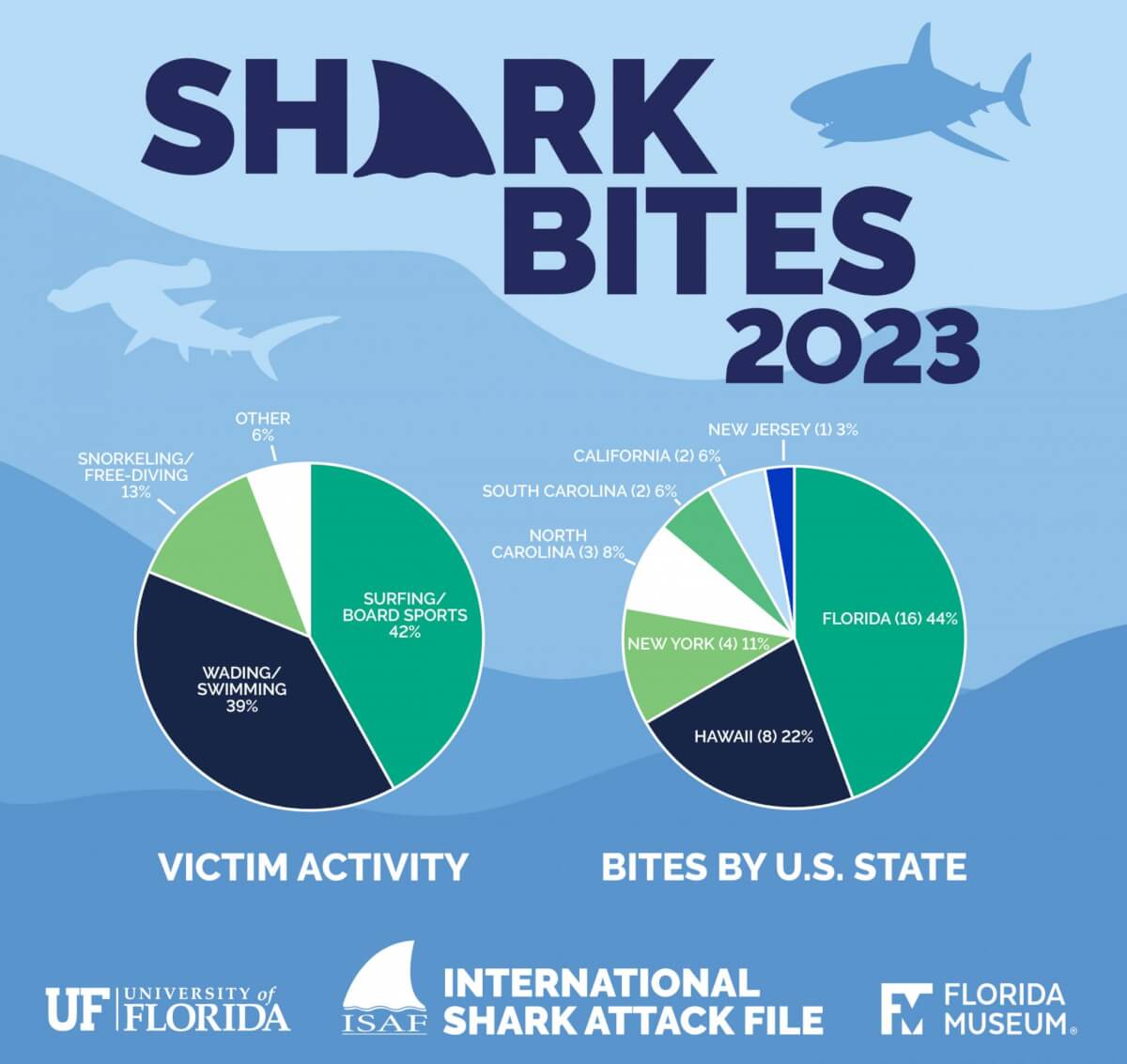🔑 Key Findings:
- There were 69 unprovoked shark attacks in 2023
- 10 attacks were fatal, double the number from 2022
- Over half of these attacks took place in the United States
GAINESVILLE, Fla. — Fatal shark attacks have doubled in the last 12 months, according to a concerning new report. In 2023, there were 10 deadly shark incidents, a significant increase from the five in 2022, with Australia experiencing a disproportionately high number of these attacks.
Additionally, the University of Florida’s International Shark Attack File (ISAF) reported a rise in the overall number of unprovoked shark attacks worldwide last year. Shark experts say these findings are alarming.
The year 2024 marks the 50th anniversary of the iconic novel “Jaws,” and it is noteworthy that the incidences of recorded white shark bites have seen a sharp increase over the past few decades. However, the research team suggests that this pattern is not due to increased aggression among white sharks. Instead, it reflects the growing number of people spending time in the ocean and a greater focus on the reporting of shark bites and fatalities.
The ISAF, which maintains a scientific database of global shark attacks, recorded a total of 69 unprovoked shark bites in 2023. Despite this figure being higher than the recent five-year average of 63 attacks, experts consider it consistent with long-term trends.
In 2023, Australia was the location for 22 percent of all shark attacks and 40 percent of fatalities. Additionally, there were two confirmed deaths in the United States and one each in the Bahamas, Egypt, Mexico, and New Caledonia. Other countries where confirmed, non-fatal shark bites occurred include Costa Rica, Colombia, Brazil, New Zealand, Seychelles, Turks and Caicos, the Galápagos Islands, and South Africa.

“This is within the range of the normal number of bites, though the fatalities are a bit unnerving this year,” says Gavin Naylor, director of the Florida Museum of Natural History’s shark research program, in a media release.
In the United States, there were 36 unprovoked shark attacks, constituting 52 percent of the global total. Among these, two were fatal: one occurred in California and the other in Hawaii. Consistent with previous years, Florida recorded more shark attacks than any other state, totaling 16 incidents.
The International Shark Attack File (ISAF) examines and documents all shark bites on humans, with the annual report primarily emphasizing unprovoked attacks. These are characterized as incidents where a shark, in its natural habitat, initiates an attack without any provocation from humans.
“We’re biologists, and we want to understand the natural behavior of the animals — not the unnatural behavior,” Naylor adds.
Last year, the International Shark Attack File (ISAF) recorded an additional 22 attacks that were either intentionally or unintentionally provoked. Spearfishing emerged as the most common activity victims were engaged in at the time of these provoked attacks.
In 2023, three fatalities were reported at a remote surfing destination off the coast of Southern Australia, known as the Eyre Peninsula. This area is celebrated for its wild, untamed beaches and exceptional surf breaks. Despite the challenges associated with accessing and navigating it, the Eyre Peninsula remains a captivating destination for surfers.
The region is also notable for its seal colonies and a high concentration of white sharks, contributing to its reputation as a prime location for both surfing and shark encounters.
“If a white shark is going after a seal and the seal knows it, the white shark hasn’t got a chance,” Naylor continues. “Seals are really agile, so the only ones that get caught are the ones that are goofing off and flopping around on the surface minding their own business. And that’s kind of what a surfer looks like.”

Last year, surfers accounted for 42 percent of shark bite victims worldwide, while swimmers and waders comprised the second largest group at 39 percent. In addition to its coastal white shark populations, Australia also hosts bull sharks in and around its rivers. Early in the previous year, a fatal bull shark attack occurred in a river near the coast.
“Beach safety in Australia is second to none. They’re fantastic,” says Joe Miguez, a doctoral student in the Florida Program for Shark Research. “However, if you go to remote regions where beach safety isn’t in place, there is a higher risk of a fatal shark attack. This is because when an attack happens and there is beach safety, you can get a tourniquet on sooner and save the person’s life. So, the solution isn’t to not surf. It’s to surf in areas where there’s a good beach safety program in place.”
The findings indicate that the vast majority of unprovoked attacks are test bites, occurring when a shark mistakenly identifies a human as its preferred prey. In such instances, the shark usually swims away after delivering a single bite.
However, certain species, including white sharks and tiger sharks, are so large that even a single bite can be fatal. One of the fatal attacks recorded involved a tiger shark in the vicinity of the Red Sea’s banks in Egypt.
“The bite in Egypt stood out because a video shows a tiger shark taking multiple passes at a human in the water. Even though predation events are exceedingly rare, it’s pretty clear that’s what it was,” Miguez explains.
Despite the increase, researchers note that the number of bites and fatalities recorded in 2023 falls within the average range for the past decade. Annually, there are consistently fewer than 100 unprovoked shark bites, rendering the likelihood of winning the lottery higher than that of being attacked by a shark.
Shark attacks most commonly occur during the summer months in both the Northern and Southern Hemispheres, a time when many shark species are more active and more people are in the water. Included in last year’s statistics is the first known shark attack in New York City in over 50 years.
“It causes a lot of fear, but the reality is you’re putting a lot of people in the water on a hot day with bait fish in the water,” Naylor concludes.
While the likelihood of being bitten by a shark is incredibly low, the International Shark Attack File (ISAF) advises swimmers to stay close to shore, avoid swimming at dawn or dusk, and refrain from excessive splashing to minimize risks.

From my perspective as a long time Cape Codder sharks started coming near shore after the tremendous increase in seals congregating along the beaches~a result of the sea mammal protection act.
It’s also possible that their food supply in the deeper oceans is dwindling. They may be coming where food is – beaches where humans congregate.